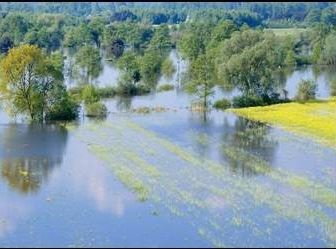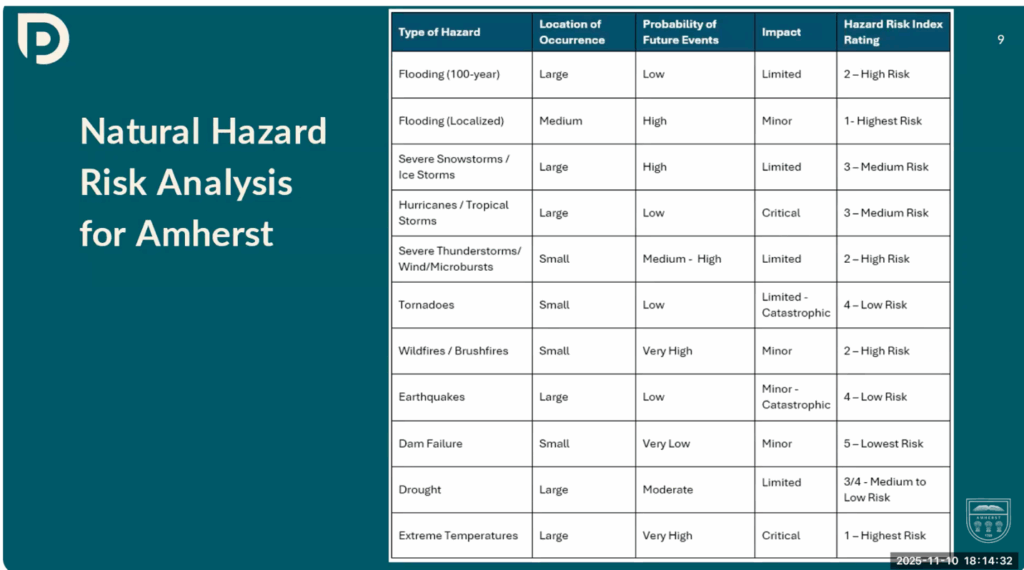New Hazard Mitigation Plan Gauges the Town’s Readiness for Climate Change

Photo: amherstma.gov
More Opportunities for Public Input Coming Soon
Amherst held a public hearing on a proposed update on the town’s Hazard Mitigation Plan on November 10. The meeting was held in Town Hall with a Zoom option and was recorded.
The town received a grant for the Pioneer Valley Planning Commission (PVPC) to develop an update to its 2016 plan. Fire Chief Lindsay Stromgren stated that a 10-year update is required by the Federal Emergency Management Agency (FEMA) for the town to be eligible for grants to address local emergencies. He said that about 20 people from the town and UMass had attended several meetings with PVPC over the past year to develop the new plan.
Mimi Kaplan of PVPC presented the new draft plan. She said that this was the first of two public hearings that would gather input from the public to be used in formulating the final plan. The draft will be posted on the town website, and a second public hearing will be held, probably in January, 2026. The plan must then be approved by the Massachusetts Emergency Management Agency and then by FEMA, before ultimately being accepted by the Town Council.
Kaplan pointed out the difference between the Hazard Mitigation Plan and the Emergency Preparedness plan. She said that the Hazard Mitigation Plan deals primarily with natural disasters and the results of climate change and what we can do to minimize their impacts. This differs from an emergency plan, which includes emergency shelters, radio communications equipment, and emergency response drills. She stated that hazard mitigation is “any sustained action taken to reduce or eliminate long-term risk.” This involves limiting development in high-risk areas, retrofitting structures to protect them from flood and high winds, improving drainage and flood control, and fire safety education.
In light of the recent large fire at Olympia Drive, which occurred three days prior to this meeting, Stromgren emphasized that the Hazard Mitigation Plan does not address the number of firefighters, the condition of the fire station, or the equipment available.
The five components of a Hazard Mitigation Plan are:
- Hazard identification and description
- Identification/mapping of critical infrastructure
- Risk assessment: how hazards impact buildings, property, and residents, especially vulnerable populations
- Assessment of the town’s mitigation capabilities
- Review of previous mitigation strategies and identification of new mitigation strategies.
Kaplan stated that FEMA estimates that every dollar spent on hazard mitigation saves six dollars on future disaster losses. Plus, the preparation makes communities more resilient to natural hazards and the impacts of climate change and could save lives.

As listed in the above chart, the highest risks for Amherst are increasing heat, with an estimated 60 days of temperatures over 90 degrees by the end of the century and 65 fewer days below freezing; a threefold risk of flooding, especially near West Pomeroy Lane, Main Street at the Fort River, Station Road, Potwine at Plum Brook, University Drive, and Fearing Street at the Tan Brook; and also a risk of severe thunderstorms with associated power outages. The complete draft of the new plan is expected to be completed next month and will be available on the town website.
The goals for the 2016 plan, which were partially realized, were to: acquire land prone to flooding (such as Hickory Ridge), revise the standards for site plan review to promote green infrastructure, conduct outreach to populations unfamiliar to winter weather hazards (such as frozen pipes), identify vulnerability to cellular communication infrastructure, and review the existing evacuation plan.
Public Comments and Questions
Most members of the public did not identify themselves when speaking. The first speaker recommended engaging residents to keep storm drains free of debris, especially in light of the rapidity of climate change.
Robin Jaffin noted that the increase in drought and high winds makes it more dangerous to conduct managed burns of vegetative materials.
Another resident cited the importance of tree management and the impact on communication if wires and cell towers go down. Ana Devlin Gauthier also spoke for several modes of communication to be used in case of emergency and for putting power lines underground, where they are safe from high winds and falling branches. Stromgren said that the town is moving to a new communication system using the town fiber network and also built-in redundancy with a microwave system.
An attendee noted that rising groundwater will be worse with warmer winters, which could cause septic systems to fail. This commenter urged that the town conduct a town-wide assessment of stormwater management and maintenance of drainage ditches.
Lenore Bryck noted that it is important to consider the dangers to natural ecosystems from overdevelopment in sensitive areas, such as forests and floodplains. She stated that it is important to consider the town’s water supply and infrastructure when planning development.
Town Councilor George Ryan suggested that town staff attend district meetings to present the draft plan to residents and obtain more feedback. Stromgren replied that residents can also comment on the draft plan when it is posted on the town website, most likely in December. He added that the town will work on updating the Emergency Preparedness plan over the next year.
As far as implementing the recommendations of the Hazard Mitigation Plan, Stromgren noted that much falls to the Department of Public Works, but other departments will be responsible for areas in their purview. Members of the stakeholders group that developed the plan will oversee its implementation and help apply for available grants.
